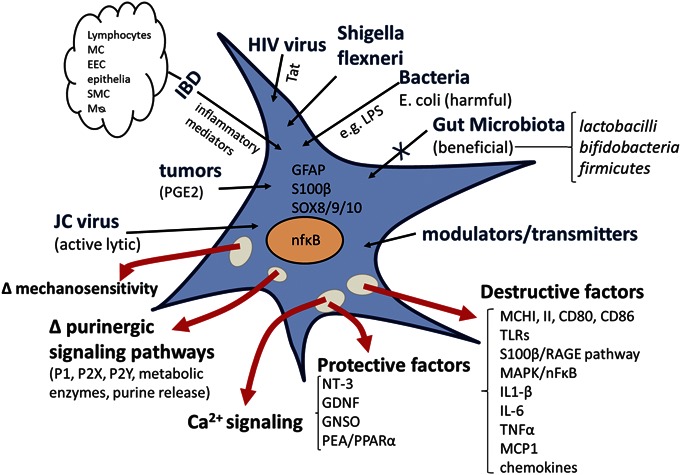FIGURE 4.

Working model of activation of EGC and induction of a “reactive EGC phenotype,” in ENS: a variety of neurotransmitters and potential gliotransmitters can activate EGC including 5-HT, ACh, GABA, glutamate, lipids, ATP, uridine triphosphate, ADP, and adenosine. Intestinal infection with bacteria or viruses, inflammatory mediators, IBD, or POI can induce a reactive glial cell phenotype. HIV virus or JC virus can infect hEGC and cause phenotypic changes, associated with changes in neural behavior. Bacterial infection with AIEC or Shigella flexneri can activate EGC, but they can discriminate between these pathogenic bacteria and probiotic bacteria (Lactobacillus paracasei). Inflammatory mediators released in the gut in response to infection, IBD, or POI can activate EGC. The “reactive glial phenotype” can release protective factors (neurotrophin-3, GDNF, GNSO, and PEA/PPAR-α) or destructive factors (proinflammatory mediators such as IL1β, IL-6, tumor necrosis factor-α, MCP-1, activation of the mitogen-activated protein kinase/NF-κB proinflammatory transcription pathway, upregulation of MHC class II molecules, and activation of TLRs). Such insults in various pathologic situations can alter EGC mechanosensitivity, Ca2+ signaling, and purinergic signaling. Abnormal glial function is expected to alter neuron-to-glial communication, neural circuit behavior in the ENS, neuromuscular transmission, and GI motility. Mø, macrophage; EEC, enteroendocrine cells; SMC, smooth muscle cells; TLR, Toll-like receptors.
